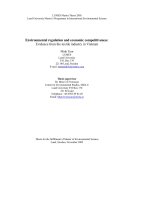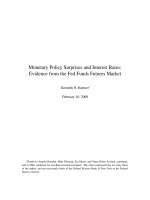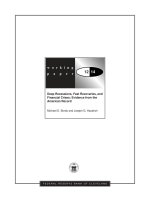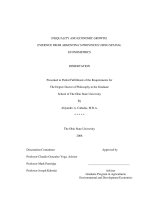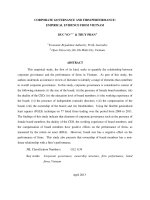Corporate governance and firm performance evidence from the u k using a corporate governance scorecard
Bạn đang xem bản rút gọn của tài liệu. Xem và tải ngay bản đầy đủ của tài liệu tại đây (986.1 KB, 232 trang )
CORPORATE GOVERNANCE AND FIRM PERFORMANCE:
EVIDENCE FROM THE U.K. USING A CORPORATE
GOVERNANCE SCORECARD
LUO LEI
(M.Sc, NUS)
A THESIS SUBMITTED
FOR THE DEGREE OF DOCTOR OF PHILOSOPHY
DEPARTMENT OF FINANCE AND ACCOUNTING
NATIONAL UNIVERSITY OF SINGAPORE
2006
I
ACKNOWLEDGEMENT
I sincerely believe that, without the help from many people who have constantly
supported me throughout my candidature, this thesis would not be possible.
The fist person I wish to express my deepest appreciation and gratitude is none
other than my supervisor, Associate Professor Mak Yuen Teen. He is always there
when I encounter any difficulties. This study would not have been possible without
his expertise, constant guidance and patience all the way. Words cannot express my
gratitude.
A huge word of gratitude is owed to members of my dissertation committee, Dr.
John Sequeira and Dr. Cheng Nam Sang for sharing their time, ideas, and expertise
with me, and for providing helpful comments. Thanks must be given to Associate
Professor Lee Inmoo and Associate Professor Loh Lye Chye, Alfred. Their
constructive comments were very helpful for the improvement of the thesis. I also
wish to thank my friends Cui Huimin, Miti Garg and Sumeet Gupta for their kindness
and encouragement.
My research has been supported by a scholarship provided by National University
of Singapore, which I am most grateful for.
Last but not the least, I wish to express my greatest appreciation to my beloved
parents and my boyfriend Xing Nan − for their everlasting love and encouragement.
They have always inspired me to follow my dream, encouraged me up when I
suffered setbacks, and contributed most to make my life achievements.
II
TABLE OF CONTENTS
ACKNOWLEDGEMENT I
TABLE OF CONTENTS II
SUMMARY V
LIST OF TABLES VII
LIST OF FIGURES IX
CHAPTER 1 INTRODUCTION 1
1.1 INTRODUCTION 1
1.2 MOTIVATION OF THESIS 2
1.3 OBJECTIVE OF THESIS 8
1.4 POTENTIAL CONTRIBUTIONS OF THESIS 9
1.5 ORGANIZATION OF THESIS 11
CHAPTER 2 LITERATURE REVIEW 12
2.1 MODELS OF CORPORATE GOVERNANCE 12
2.2 AGENCY THEORY 13
2.2.1 Introduction to Agency Theory 13
2.2.2 Agency Costs 14
2.2.3 Sources of Agency Conflicts 15
2.3 CORPORATE GOVERNANCE MECHANISMS 17
2.3.1 Corporate Boards 19
2.3.2 Corporate Financial Policy 20
2.3.3 Blockholders and Institutional Investors 20
2.3.4 Managerial Remuneration 21
2.3.5 Managerial Ownership 22
2.3.6 The Managerial Labor Market 23
2.3.7 The Market for Corporate Control 24
2.4 THEORETICAL WORK ON INVESTOR PROTECTION 24
2.4.1 Predicting Corporate Governance Choices of Firms 26
2.4.2 Corporate Governance and Firm Performance 27
CHAPTER 3 HYPOTHESIS DEVELOPMENT 34
3.1 PREDICTING CORPORATE GOVERNANCE CHOICES OF FIRMS 34
3.2 CORPORATE GOVERNANCE AND FIRM PERFORMANCE 37
3.3 CORPORATE GOVERNANCE AND STOCK RETURNS 39
CHAPTER 4 DATA AND DESCRIPTIVE STATISTICS 45
4.1 SAMPLE AND DATA SOURCES 45
4.1.1 U.K. Regulatory Requirements and Corporate Governance
III
Scorecard 45
4.1.2 Data Source 48
4.1.3 Sample Selection 49
4.2 DESCRIPTIVE STATISTICS OF CORPORATE GOVERNANCE SCORE 50
4.2.1 Description of Corporate Governance Score 50
4.2.2 Industry Composition 51
4.2.3 Individual Corporate Governance Sub-scores 53
4.2.4 New Firms and Corporate Governance Score Change 55
4.2.5 Corporate Governance Score over Time 60
4.2.6 Survivorship Problem 62
4.3 DESCRIPTIVE STATISTICS OF VARIABLES 64
CHAPTER 5 DETERMINANTS OF CORPORATE GOVERNANCE
AND THEIR RELATIONSHIPS WITH FIRM VALUE 72
5.1 DETERMINANTS OF CORPORATE GOVERNANCE 72
5.1.1 OLS Estimates of the Determinants of Corporate Governance 72
5.1.2 OLS Estimates of the Determinants of Change in Corporate
Governance 77
5.2 CORPORATE GOVERNANCE AND FIRM VALUE 80
5.2.1 Corporate Governance and Firm Value: Empirical Results 80
5.2.2 Categories and Factors Associated with Firm Value 85
5.2.3 Corporate Governance, Free Cash Flow, and Firm Value:
Empirical Results 92
5.2.4 Analysis of the Relationship among Corporate Governance, Free
Cash Flow and Firm Value, Using Simultaneous Equations
System 103
5.3 SUMMARY 119
CHAPTER 6 CORPORATE GOVERNANCE AND STOCK RETURNS 121
6.1 ABNORMAL RETURNS FROM TRADING STRATEGIES ON CORPORATE
GOVERNANCE 121
6.2 DISTINGUISHING BETWEEN THE RISK AND MISPRICING EXPLANATIONS
FOR
EXCESS RETURNS TO GOVERNANCE-IMPROVING FIRMS 128
6.2.1 Evidence on Risk Explanation for Excess Returns to Governance
Change Firms 128
6.2.2 Evidence on the Mispricing Explanation for Excess Returns to
Governance Change Firms 144
6.3 SUMMARY 161
CHAPTER 7 CONCLUSION 163
7.1 SUMMARY OF RESEARCH FINDINGS 163
7.2 CONTRIBUTIONS AND IMPLICATIONS 164
7.3 LIMITATIONS AND FUTURE RESEARCH 166
IV
BIBLIOGRAPHY 169
APPENDICES A1-1
V
SUMMARY
In this thesis, I examine three corporate governance related issues, namely, the
determinants of corporate governance, the relationship between corporate governance
and firm performance, and the impact of corporate governance on stock returns.
Exploring the determinants of firm-level governance, I find that an improvement
in investment opportunities, an increase in external financing needs, R&D reporting
availability, and an increase in free cash flow, are positively related to an
improvement in corporate governance.
My findings reveal an interesting relationship between corporate governance and
firm performance, namely, that it is the change in corporate governance rather than
the level of corporate governance that determines performance. In investigating
possible reasons for the underlying relationship between governance and performance,
I find that both free cash flow and cost of equity capital help to explain the positive
association between Tobin’s Q and improvements in corporate governance.
Specifically, I find that improvements in corporate governance prevent managers from
stockpiling large reserves and as such reduce some of the adverse effects of excess
cash holdings on firm value. Furthermore, I find that improvements in corporate
governance reduce the firms’ cost of equity and I also observe a positive relationship
between governance change and a firm’s future operating performance.
Whether the positive relation between a firm’s performance and governance
change is understood by the market is another important issue that I address in this
thesis. My results show that post-investment returns are positively related to
governance change rather than the level of governance. An investment strategy that
VI
buys governance-improving firms and shorts governance-deteriorating firms is found
to earn an average monthly return of 72 basis points, or about 8.6% per year. Tests to
establish whether the abnormal returns accruing to the improvement portfolio is due
to mispricing or risk are inconclusive.
VII
LIST OF TABLES
Table 1: Sample size for the study period 50
Table 2: Summary statistics of corporate governance scores 51
Table 3: Industry composition – by divisions 52
Table 4: Summary statistics for individual categories 54
Table 5: Correlation matrix for the overall corporate governance score and individual
category scores 55
Table 6: Number of observations in each year 55
Table 7: List of top 10 corporate governance firms in each year 56
Table 8: List of the top 10 score change firms in each year 58
Table 9: Distribution of corporate governance level and change in the same time
period 61
Table 10: Corporate governance change in the subsequent year for CG low, CG
middle, and CG high groups 61
Table 11: Differences between surviving firms and delisted firms 63
Table 12: Descriptive statistics 67
Table 13: Pearson correlations among endogenous variables and other variables 69
Table 14: Determinants of corporate governance: OLS regressions of SCORE on
ownership and/or firm characteristics variables (fixed effects) 76
Table 15: Determinants of change in corporate governance: OLS regressions of
∆SCORE on ownership and/or firm characteristics variables 78
Table 16: Determinants of firm value: OLS regressions of FUTUREQ on SCORE,
ownership and/or firm characteristics variables (fixed effects) 82
Table 17: Determinants of firm value: OLS regressions of FUTUREQ or ΔQ on
ΔSCORE, SCORE, ownership and/or firm characteristics variables 83
Table 18: OLS results for sub-scores (fixed effects) 87
Table 19: Determinants of firm value: OLS regressions of FUTUREQ on
standSCORE, ownership and/or firm characteristics variables 89
Table 20: OLS results for standardized sub-scores (fixed effects) 90
Table 21: Corporate governance and corporate cash holdings: OLS regressions of
CASH on ΔSCORE, SCORE, ownership and other control variables 95
Table 22: Determinants of firm value: OLS regressions of FUTUREQ or ΔQ on
ΔSCORE, SCORE, EXCESSCASH, ΔSCORE *EXCESSCASH and
SCORE*EXCESSCASH, ownership and/or firm characteristics variables 99
Table 23: Coefficient estimates from 2SLS regressions of control mechanisms (fixed
effects) 110
Table 24: Coefficient estimates from 2SLS regressions of the control mechanisms
including ΔSCORE 113
Table 25: Coefficient estimates from
OLS
and
2SLS regressions of Q or FURTUREQ
on control mechanisms (fixed effects) 116
VIII
Table 26: Coefficient estimates from OLS and 2SLS regressions of Q or FURTUREQ
on control mechanisms including ΔSCORE 118
Table 27: Firm characteristics and returns of corporate governance quintile portfolios
124
Table 28: Firm characteristics and returns of corporate governance change quintile
portfolios 125
Table 29:Four-factor model (“improvement portfolio” minus “deterioration portfolio”)
127
Table 30: Distributional statistics for the cost of equity capital estimates 130
Table 31: Pearson correlation coefficients among cost of equity capital estimates 131
Table 32: Validation of cost of equity capital measure 133
Table 33: Effect of corporate governance on the cost of equity capital: OLS
regressions of R on SCORE, ownership and other control variables (fixed
effects) 135
Table 34: Effect of corporate governance on the cost of equity capital: OLS
regressions of ΔR on ΔSCORE, SCORE, ownership and level of other
control variables 137
Table 35: Effect of corporate governance on the cost of equity capital: OLS
regressions of ΔR on ΔSCORE, changes in ownership and other control
variables 138
Table 36: Effect of corporate governance on market beta: OLS regressions of BETA
on SCORE and ownership variables (fixed effects) 140
Table 37: Effect of corporate governance on market beta: OLS regressions of ΔBETA
on ΔSCORE and ownership (Δownership) variables 141
Table 38: Summation estimates of regression of excess return of each individual stock
in the U.K. market on CGCE and four risk factors 143
Table 39: Effect of corporate governance on FUTUREROA: OLS regressions of
FUTUREROA on SCORE, BM, ME and/or ownership and other control
variables (fixed effects) 147
Table 40: Effect of corporate governance on future operating performance: OLS
regressions of future operating performance on SCORE, BM, and ME (fixed
effects) 150
Table 41: Regression of excess return on ROA (ΔROA) and SCORE (ΔSCORE) 153
Table 42: Analysts’ forecast errors for governance-improving and
governance-deteriorating firms 155
Table 43: Differences in one-year analysts’ forecast errors between
governance-improving and governance-deteriorating firms 156
Table 44: Returns around earnings announcements for CG change low, CG change
middle, and CG change high groups 159
IX
LIST OF FIGURES
Figure 1: Framework of the thesis 9
Figure 2: The firm (corporation): a network of contracts 14
Figure 3: Determinants of corporate governance 26
Figure 4: Two channels through which corporate governance may affect firm
performance 28
1
Chapter 1
Introduction
1.1 Introduction
Corporate governance practices in the U.K. have attracted increased attention
since the 1990s, with influential reports issued by the Cadbury Committee (1992),
Greenbury Committee (1995), Hampel Committee (1998), Turnbull Committee (2003)
and Sir Derek Higgs (2003). These reports have resulted in various corporate
governance codes and recommendations, including the Combined Code on Corporate
Governance, June 1998, July 2003 and June 2006 versions (hereafter referred to as the
U.K. Code). In the last decade, U.K. regulators and companies have made significant
efforts to improve the level of corporate governance.
However, limited empirical research has been conducted to examine the
association between corporate governance and firm performance in the U.K. market.
Most of the studies have been conducted on U.S. firms. This research examines
corporate governance in the U.K. for several reasons. First, corporate governance
characteristics of U.K. firms are more diversified. Compared to the U.S., the corporate
governance environment in the U.K. is less regulated. Compliance with the U.K.
corporate governance code is voluntary and U.K. firms are free to choose the
governance policy according to their own circumstances. Therefore, the corporate
governance characteristics are more diversified among U.K. firms compared to U.S.
companies. This research provides an opportunity for the comparison of the
effectiveness of different governance mechanisms.
2
Secondly, there were unprecedented institutional changes in U.K. governance in
1990s as a consequence of the publication of the aforementioned governance reports.
By drawing a sample of U.K. firms and comparing their performance before and after
the governance changes during that period, there is an opportunity to develop
complementary tests based on changes in governance in addition to cross-sectional
analysis. These change models are less susceptible to problems of spurious correlation
because the U.K. Code is exogenously imposed on all firms, not endogenously driven
by firm specific characteristics.
1.2 Motivation of Thesis
In addition to the reasons described above, there are several motivations for
conducting this research. While the U.K. Code puts forward a comprehensive set of
governance-related recommendations, earlier studies on the U.K. corporate
governance have only examined the impact of specific code recommendations on firm
performance [Vafeas and Theodorou (1998) on director affiliation and ownership,
chairman affiliation, and committee composition and Weir et al. (2002) on board
independence, CEO duality, audit committee, director shareholdings, leverage, and
external shareholding]. However, as pointed out by Bowen et al. (2004), ignoring the
interaction between individual governance instruments can lead to spurious
inferences.
To examine the effectiveness of overall governance standards, I use the approach
of scorecard developed by Standard & Poor’s (S&P) to assess the corporate
governance of U.K listed companies. It provides a comprehensive measure of the
extent to which a company has adopted recommended best practices in corporate
governance, as revealed in their corporate governance disclosures.
3
The approach used is similar to that adopted to study U.S. companies (Gompers et
al., 2003; Bebchuk et al., 2005; Larcker et al., 2005; Brown and Caylor, 2006; Gillan
et al., 2006), 14 emerging markets (Klapper and Love, 2004), companies in 27
countries (Durnev and Kim, 2005), S&P Supercomposite 1,500 companies and other
large, publicly-traded firms (Gillan et al., 2003; 2006), EMU (European Monetary
Union) and U.K. companies (Bauer et al., 2004), and U.K companies (Shabbir and
Padgett, 2005).
Akin to these studies, this research also uses the score as a broad measurement of
corporate governance. Corporate governance measures used in the earlier studies are
constructed from two sources: (1) constructed by some rating agencies (CLSA index
or S&P index) and (2) constructed by the authors using a set of observable indicators.
Studies show that both CLSA and S&P indices are fairly weak predictors of firm
value. This could be because that the CLSA index is a subjective measurement and
the S&P index is limited to disclosure. In addition, both indices are abandoned by
their sponsors, precluding us to conduct time series analysis. Self-constructed indices
are not subject to these constraints, but generally include a small number of
governance indicators only. For example, the index in Padgett and Shabbir (2005)
includes only 12 governance items. The scores used in this research are
self-constructed indices, broader in scope (including 136 items) and more dynamic
(four years) when compared to the scores used in previous studies.
Previous studies provide weak evidence in support of the existence and reasons
for a link between governance structure and performance, which may be due to the
weaknesses in the research methodology which are described above. Many of earlier
studies on corporate governance have examined subsets of governance mechanisms,
usually using only one or two governance variables. These variables are insufficient to
4
represent the governance standard and hence show little relevance to the performance.
More recent studies employ a broader measurement of corporate governance through
a composite rating. However, these studies are based on governance ratings for one or
two years only, and assume they remained constant for a number of years. This
assumption may not hold. Firms can choose and modify the structure of their
governance systems to suit their circumstances. Denis and Sarin (1999) suggest that
ownership and board structures adjust frequently to economic shocks, leading
observed ownership and board structures to be considerably less stable than
commonly believed. Therefore there could be systematic biases in previous studies of
static examination of governance structure that assume constant ownership and board
structure over time.
In this research, I propose to examine not only the level but also the changes in
governance variables. The governance structure shall also be examined over a longer
period for the firms in the sample. Klapper and Love (2004) find that governance
mechanisms may be affected by firm-specific environments. However, they are not
able to analyze the causality between governance mechanisms and firm performance
because their governance data has no time variation. My study extends beyond
previous studies by analyzing a number of corporate governance mechanisms based
on time-varying, firm-specific data.
Some researchers (Hermalin and Weisbach, 1988 and 1998; Gillan et al., 2003;
Lehn et al., 2004; Cremers and Nair, 2005) explain the weak link between governance
level and firm performance using the contracting efficiency theory. They argue that a
high agency cost firm will have a higher level of governance compared to a low
agency cost firm to control the agency problem. However, firms with higher
governance standards do not necessarily have better performance.
5
The objective of the release of the first combined code in the 1990s was to raise
standards of governance. Firms were expected to have improved performance by
strengthening their internal governance structure. However, according to the
contracting efficiency theory, we would expect that most firms had a certain level of
governance based on their environments before the release of the codes. Firms would
decide not to comply with higher level of standards if the costs of implementing these
standards were higher than the expected benefits. Given this cost-benefit tradeoff, it is
unclear as to whether improved governance as reflected by higher compliance is
associated with improvement in firm performance. This study investigates the
desirability of governance rules on corporations by testing costs/benefits to firms with
compliance or non-compliance.
Previous study found some endogeneity between corporate governance and firm
performance. For example, Vafeas (1999) finds that boards’ meeting frequency is
negatively related to firm valuation but increased frequency of board meetings is
positively related to future operating performance. It suggests that the positive
relationship between corporate governance and firm performance is more pronounced
when corporate governance changes. Therefore any cross-sectional regression of
performance on board composition will be biased because changes in corporate
governance may result merely from past performance. An important improvement of
my methods over previous studies is the use of panel data and the analysis on change
in corporate governance instead of the level of corporate governance, which reduces
the endogeneity problem.
A few studies have examined the impact of change of governance on firm
performance. Some researchers (Nesbitt, 1994, 1995, 1997, 2001; Carleton et al.,
1998; Caton et al., 2001; English et al., 2001; Anson et al., 2003) study how activist
6
funds reap high stock returns by purchasing shares of low governance firms and
improving their governance structures. In particular, Becht et al. (2006) analyze
targeted, high-intensity shareholder activism over the period 1998-2004 by the
Hermes U.K. Focus Fund (HUKFF). They observe that HUKFF buys into
poorly-governed companies and pushes for changes, which include corporate
restructurings, changes to the boards of firms, and restrictions on corporate policies.
They report significantly positive returns around the announcements of desired board
changes, increased payouts, and major restructurings.
The case of HUKFF suggests that institutions-initiated governance improvement
can lead to improved firm performance. My study extends the Becht et al.’s (2006)
work to the area of voluntary improvement in corporate governance. It is interesting
to inquire whether the market also rewards the firm which voluntarily improves its
corporate governance. If the market responds positively to the voluntary
improvements, it suggests that firms can improve their performance by raising the
governance standards. If the market does not reward governance improvement, it
simply suggests that the high stock returns attained by activist funds are more
dependent on the institution’s skills in picking the right firm.
This study extends the work of Becht et al. (2006) in two other ways. First, Becht
et al. (2006) examine market perceived benefits instead of realized benefits of
engagement. Second, they focus on short-term market reaction. As suggested by
Gompers et al. (2003), a “long-run event study” is a better approach to examine the
wealth effect of a governance provisions index. In this study, I investigate whether
change in governance results in realized change in firm performance and whether
investors can obtain abnormal returns over a long period.
I study whether there are higher stock returns for those firms that voluntarily
7
improve governance to comply with the combined code. My analysis adds to the
research of Grinstein and Chhaochharia (2005) who study the announcement effect of
the Sarbanes-Oxley law (SOX) and the amendments to the stock-exchange regulations
on firm value. They find that non-complying firms are valued higher because the
market expects them to improve corporate governance in the future. Their study does
not analyze whether firm performance improves when real improvement in corporate
governance occurs. My thesis examines actual improvements in shareholder wealth in
the long run following the actual changes in the corporate governance.
This is an important research question for two reasons. First, knowing the
economic consequences of the real improvement in corporate governance has
important policy implications, because its effectiveness had been taken for granted
when the U.K. Code was established. Empirically, we need to test whether firms
making efforts to comply with the U.K. Code are rewarded by the capital market.
Second, the best way to detect positive results of the U.K. Code is to assess the
long-term performance effects of changes in the degree of Code compliance.
My thesis also looks into the reason behind the positive relationship between
corporate governance and stock returns. Agency problems may affect the value of
companies through two distinct channels: (1) the expected cash flows accruing to
investors and (2) the cost of capital.
First, firms with stronger governance would be more likely to have better
management of cash and thereby increasing firm value. Jensen and Meckling (1976)
suggest that better-governed firms are more likely to invest in profitable projects,
resulting in higher future cash flows. La Porta et al. (2002), Shleifer and Wolfenzon
(2002), as well as Durnev and Kim (2005) argue that good governance prevents
expropriation by managers or controlling shareholders. Jensen (1986) puts forth the
8
theory that good governance reduces the resources under the control of managers, and
thus indirectly reduces the chance of expropriation by managers.
Second, good governance decreases the cost of capital either through the reduction
of shareholders’ monitoring and auditing costs (Lombardo and Pagano, 2000b;
Garmaise and Liu, 2005) or through the reduction of information asymmetry (Easley
and O’Hara, 2002; Leuz and Verrecchia, 2004).
It is important to understand the mechanisms through which corporate governance
affects a firm’s valuation. However, these two effects of governance are usually
investigated separately. As a result, empirical studies provide little evidence on the
sources of the increases in firm value. In particular, it is unclear whether the benefits
stem from higher expectations about future cash flows, from a lower cost of capital, or
from both sources simultaneously. This thesis examines both dimensions
simultaneously. Hence, it adds to the literature on the relative magnitude of the cash
flow and cost of capital effects of corporate governance.
A large number of studies have been conducted on either the association between
corporate governance and stock returns or the association between corporate
governance and operating performance. To my knowledge, no prior studies have
examined the link between corporate governance and stock returns through operating
performance. My thesis broadens this line of research by investigating whether stock
returns can be explained by operating performance.
1.3 Objective of Thesis
This study highlights the importance of analyzing and improving the existing
corporate governance practices in the U.K. It questions whether corporate governance
change adds value to a firm.
9
To operate successfully, a firm needs a competent corporate governance structure.
Over time, if a firm finds its existing corporate governance mechanisms insufficient to
guarantee good performance, it will develop an intention to improve it. Accordingly,
the primary objective of this thesis is to explicitly illustrate that improvement in
corporate governance leads to improvement in firm performance. Specifically, this
study aims to address four issues:
(1) what are the factors that lead to the change in corporate governance;
(2) whether change in corporate governance has any effect on firm value;
(3) what effect does change in governance have on shareholder returns; and
(4) what are the sources of the correlation between change in governance and firm
value.
The framework of this study is illustrated in Figure 1 below.
Figure 1: Framework of the thesis
1.4 Potential Contributions of Thesis
This thesis tries to provide a comprehensive analysis on governance mechanisms,
Factors which Affect
Corporate Governance
Corporate Governance
Firm Value Operating Performance Stock Returns
Cost of Capital Free Cash Flow Mispricing Risk
10
including composite governance ratings and ownership and firm leverage. In
particular, this thesis contributes to the line of research that examines the relation
between corporate governance and firm value in a number of ways.
Firstly, this study takes a more holistic approach towards corporate governance
developments, asking whether improvement in governance is associated with
improvement in firm performance. The corporate governance developments in the
U.K. offer a unique laboratory to address these empirical issues. My study extends the
scope of corporate governance and firm performance literature beyond previous
studies by analyzing a number of corporate governance mechanisms based on
time-varying, firm-specific data.
Secondly, this study examines the factors that lead to change in governance score
(rather than a specific governance item) which provides a richer understanding of the
dynamics of corporate governance structures.
Thirdly, given the costs/benefits tradeoff in complying with raised standards of
governance, it is unclear whether improved governance as reflected by higher
compliance is associated with improvement in firm performance. This research
contributes to the line of literature that examines the desirability of governance rules
on corporations.
Fourthly, this study explicitly evaluates exogenous changes in governance
structure and alleviates the potential endogeneity problem. Furthermore, I use fixed
effects estimator and simultaneous equation system to mitigate concerns about
endogeneity.
Fifthly, my study extends the research on effects of institutions-initiated
improvement in governance to voluntary improvement in governance. Most of the
previous studies focus on market perceived benefits of change in governance. My
11
approach is to study the actual improvements in shareholder wealth in the long run.
Finally, this thesis contributes to and merges distinct and different streams of
research on the sources of the correlation between change in governance and firm
value. It examines the relative magnitude of the cash flow and cost of capital effects
of corporate governance. In particular, unlike previous research, this thesis directly
examines the link between operating performance and stock returns.
1.5 Organization of Thesis
The remainder of this study is organized as follows. Chapter 2 reviews literature
concerning firm-level corporate governance. Chapter 3 presents the research
hypotheses. Chapter 4 describes the sample and data used. Chapter 5 explores the
determinants of corporate governance and its relationship with firm performance.
Chapter 6 investigates further the relationship between corporate governance and
stock returns. Chapter 7 concludes with the empirical findings and presents potential
future areas of research.
12
Chapter 2
Literature Review
Chapter 2 surveys the literature. I take the agency theory perspective of corporate
governance, discussing agency costs, agency conflicts and corporate governance
mechanisms employed to mitigate agency conflicts. I especially focus on the
theoretical work of investor protection. I begin with literature regarding governance
determinants. After that, I review the literature on corporate governance and firm
performance. In prior literature, there are generally two channels through which
corporate governance may affect performance. One is free cash flow and the other is
cost of capital.
2.1 Models of Corporate Governance
Hawley and Williams (1996) identify four models of corporate control: (1) The
Simple Finance Model; (2) The Stewardship Model; (3) The Stakeholder Model; and
(4) The Political Model. The Stewardship Model assumes that managers are
trustworthy. The main roles of outsiders are to provide access to valued resources and
information and to facilitate inter-firm commitment. In the Stakeholder Model defined
by Clarkson (1994), the purpose of the firm is to create wealth or value for its
stakeholders by converting their stakes into goods and services. In the Political Model,
the allocation of corporate power, privileges and profits among owners, managers and
other stakeholders is determined by how governments favor their various
constituencies. The ability of corporate stakeholders to influence allocations between
themselves at the micro level is subject to the macro framework, which is
13
interactively subjected to the influence of the corporate sector. In fact, The Simple
Finance Model represents a subset of The Political Model.
The dominant theoretical lens for examining corporate governance is the agency
theory under The Simple Finance Model. Corporate governance, as defined by
Shleifer and Vishny (1997), is “…the ways in which the suppliers of finance to
corporations assure themselves of getting a return on their investments” (p.737). I
limit the research scope of my thesis to The Simple Finance Model under the agency
theory assumption.
2.2 Agency Theory
2.2.1 Introduction to Agency Theory
Agency theory originates from the paper of Berle and Means (1932) on the
separation between ownership and control in large corporations. One of the most
widely-cited papers on agency theory is published by Jensen and Meckling (1976).
Jensen and Meckling (1976) suggest that the firm can be viewed as a nexus or
network of contracts, implicit and explicit, among various parties or stakeholders,
such as shareholders, bondholders, employees, and society at large. Figure 2, taken
from John and Senbet (1998), provides a visual representation of the network of
contracts.
The interests of stakeholders are not always aligned. Agency problems occur
when the interests of agents are not aligned with those of principals. Depending on the
parties involved in conflicts, agency problems can be categorized as: managerial
agency or managerialism (between stockholders and management); debt agency
(between stockholders and bondholders); social agency (between private and public
14
sectors); and political agency (between agents of the public sector and the rest of
society or taxpayers).
Figure 2: The firm (corporation): a network of contracts
Source: John and Senbet (1998)
According to Jensen and Meckling (1976), shareholders are the residual claimants
after other parties, and thus shareholders’ rights are the weakest. Corporate
governance is therefore mainly designed to protect and promote the interests of
shareholders. My research will focus on the agency-principal problems between
managers and stockholders.
2.2.2 Agency Costs
Other Stakeholders
(Product and Factor Markets)
Management
Debtholders
Classes of Agency
Outside (New)
Equityholders
Management
Debtholders, Stakeholders
Government/Society
Debtholders, Government
New Equityholders
Debtholders, Stakeholders
Excessive Perquisites
Underinvestment
Overinvestment
Risk Shifting
Asymmetric Information
Bankruptcy and Financial Distress
Government/
Society
Firm
15
Jensen and Meckling (1976) show how investors in publicly-traded corporations
incur costs in monitoring and bonding managers to best serve shareholders. They
define agency costs as being the sum of the cost of monitoring management (the
agent); bonding the agent to the principal; and residual losses. As with any other costs,
agency costs will be captured by financial markets and reflected in a company’s share
prices.
Corporate governance can be viewed as a set of mechanisms to reduce agency
costs in order to assure suppliers of finance of the return on their investments. The
objective of corporate governance is to encourage the management to make the same
decisions that owners would have made themselves, such as investment in positive net
present value (NPV) projects.
2.2.3 Sources of Agency Conflicts
With separation of ownership and control, the actual operations of the firm are
conducted by managers whose interests are not fully aligned with its owners. There
are four basic sources of conflicts: (1) moral hazard; (2) earnings retention; (3) time
horizon; and (4) risk aversion.
Moral Hazard
Jensen and Meckling (1976) show that a manager’s incentive to consume private
perquisites increases as his ownership in the company declines. Moral hazard is also
represented by the lack of effort in management. Shleifer and Vishny (1989) argue
that managers prefer making investment best suited to their own personal skills, to
increase both their own value to the firm and the cost of replacing them. In addition,
Grenadier and Wang (2005) show that moral hazard together with adverse selection
